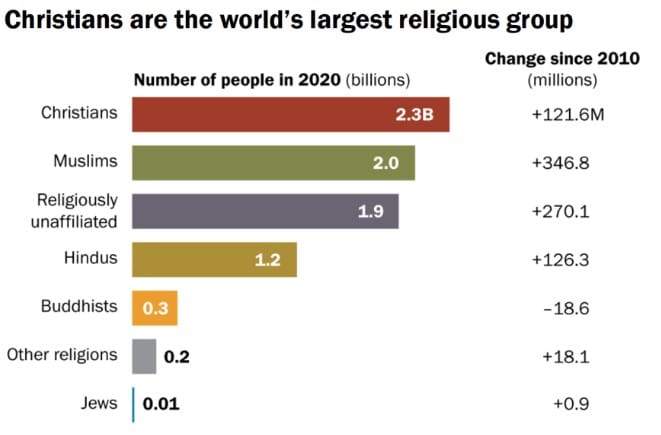
Between 2010 and 2020, Christianity, which is still the world’s biggest religious group, saw a decline while Muslims have relatively increased. A new report by Pew Research Centre, titled How the Global Religious Landscape Changed From 2010 to 2020, collected data from over 2,700 surveys and censuses in 117 countries.
Rapid growth of Islam
It is observed that between 2010 and 2020, Islam grew rapidly. The Muslim population rose by 347 million, more than all other religions combined. The share of the world’s population that is Muslim rose to 25.6 percent.
“Although Christian believers rose by 122 million, reaching 2.3 billion, their population has fallen by one percent, to 28.8 percent,” the report read.

Rise of non-believers
In an interesting discovery, the report states that people with no religious affiliation, atheists, rose by 270 million, reaching 1.9 billion. They have climbed to 24.2 percent, next to Muslims.
“Collectively, 75.8 percent of the world’s population identified with a religion as of 2020. The remaining 24.2 percent did not identify with any religion, making people with no religious affiliation the third-largest group in this study, after Christians and Muslims,” the report read. Their population continues to grow as many are “switching out of Christianity.”
Meanwhile, Hindus, the majoritarian in India, have risen by 126 million, reaching 1.2 billion worldwide.
Young population and high fertility rate
One major reason for the Muslim population growth is largely driven by their relatively young age structure and high fertility rate. A younger population has an upper demographic hand as many consist of women who have entered or will soon enter their childbearing years.
Muslims were estimated to have the highest total fertility rate, with an average of 3.1 children per woman in the 2010-15 period, according to a previous Pew Research Centre study.
In 2010, Muslims had the highest proportion of children, with 35 percent under the age of 15. Hindus followed with 31 percent.
Religious switching
Christianity is witnessing a high rate of religious switching, moving away from the religion they were born. This mostly happens in the early adult years.
The world is seeing a large increase in people with no religious affiliation through religious switching. “On average, for every 100 people, ages 18 to 54, who were raised with no religion, 7.5 people have left and 24.2 have joined the ranks of the unaffiliated, resulting in a net gain of 16.7 people,” the report read.
In contrast, Muslims and Hindus are the least affected by religious switching.
Migration
According to the study, migration may not drastically change the size of religious groups, but it may influence their geographic spread.
The report mentions that in 2010, the Muslim population in Lebanon was recorded at 62 percent. In 2020, Muslims are now at 65 percent, after the influx of Syrian refugees. Muslims make up six percent of Europe.
On the other hand, the six GCC countries (Bahrain, Kuwait, Oman, Qatar, Saudi Arabia and the United Arab Emirates) account for a quarter of the migrant population, which is made up mostly of Christian and Hindu residents.



